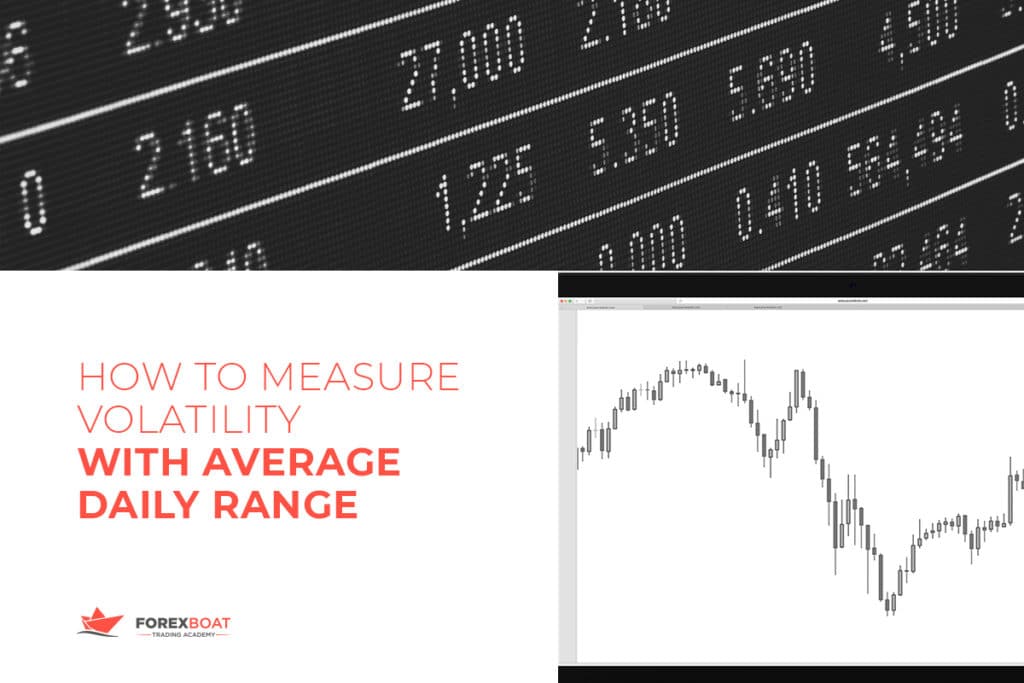In trading, like in life, simple things work best. Traders that search how to measure volatility use the average daily range for it.
The idea is not a bad one. The average daily range represents the purest form of interpreting a market.
The Forex dashboard consists of multiple currency pairs. Either a major pair or a cross, each currency pair moves at its speed.
Some pairs consolidate most of the time. Others, trend more.
As such, the distance traveled differs. The range covered changes.
Because of that, traders apply different strategies when trading the market. Believe it or not, the average daily range gives more than the distance the price travels.
It gives an idea about how to measure volatility too.
In this article, we’ll cover different ways to use the average daily range. And, we’ll look at how to measure volatility based on the info provided by the average daily range.
At the end of it, you’ll have an idea about:
- How to use the average daily range to your advantage
- How to measure volatility with the daily range
- Forex trading strategy with the average daily range indicator
- How to apply the average daily range indicator to a chart
- How to measure volatility with the average daily range
- Tips and tricks when using the average daily range
Moreover, we’ll connect volatility with fundamental analysis. As such, you’ll find out it is a direct connection between the two.
Knowing how to benefit from it represents a competitive advantage. Why not use it?
Average Daily Range Interpretation
A range represents the distance between the highest and lowest price during a specified period. Hence, the daily range shows the distance a currency pair traveled in a day.
However, one shouldn’t confuse it with the opening and closing prices. Those don’t reflect the daily range.
As a trading tool, the average daily range proves to be valuable. It gives an idea about expectations for a trade.
For example, let’s say your take profit for a trade is two hundred pips. Is it realistic to expect it to come in one day?
If the average daily range for that currency pair is around two hundred pips, you might stand a chance. Otherwise, the market should take a longer time to reach the target.
Moreover, the average daily range doesn’t show a market’s movement. I mean, it does. But, there’s a catch.
It may be that the price returns to the initial levels. However, the average daily range still holds.
The period considered matters too. The longer the period, the more accurate the information.
Average Daily Range Calculator
To calculate the average daily range of a currency pair, traders follow several steps. First, they open the daily chart.
Second, they look at the previous days and find the highest and lowest values. Finally, they average the outcome.
Of course, no one does that today. Nowadays, computers do everything.
As such, traders use the average daily range indicator. It automatically calculates the data for various periods of time.
But, the average daily range indicator mt4 platform offers, doesn’t come with the default settings. Traders need to import it.
That’s super easy. Simply search the Internet for the average daily range forex indicator. Next, save it to your desktop.
Finally, copy and paste it in the Indicators folder in your mt4 platform. You need to restart the platform to find it.
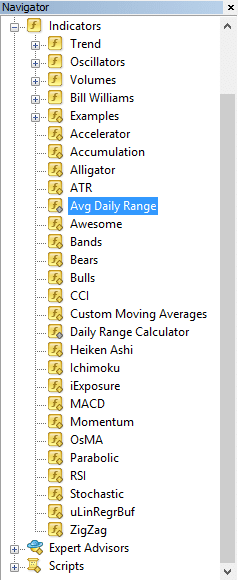
In the image above there are two average daily range indicators. Because it is a custom indicator, there are different versions of it. However, they show the same data.
How to Use the Average Daily Range
No trading day is like the previous one. That’s what makes Forex trading interesting.
Even though we deal with the same inputs, the outcome differs. The market reacts differently to the same inputs.
Think of the Federal Reserve of the United States. In the last few months, it started a tightening process.
It raised the federal fund’s rates from zero to above one percent. When interest rates rise, the currency appreciates.
I mean, that’s textbook material. However, buying the U.S. dollar wasn’t a great decision. It sank to six-year lows.
Even if almost always a currency rises with interest rates, this time it didn’t. Therefore, we had a different market reaction to the same input.
The same principle applies to the average daily range Forex traders consider. No trading day is the same.
It has different volatility moments. Moreover, no trading week is the same either. Sometimes the market moves faster. Some other days it simply stays still.
But, we can use the distance traveled to calibrate the expectations.
Interpreting a Trading Day with the Average Daily Range
A trading day has three trading sessions: the Asian, London and New York. The average daily range refers to all three of them.
But, volatility differs from session to session. Typically, the Asian session is slow.
So slow, that many Asian Forex traders simply skip it. They either scalp (trade for tiny targets). Or, only wait for London to kick in.
Let’s consider the EURUSD daily chart. Below there’s the average daily range applied to it.
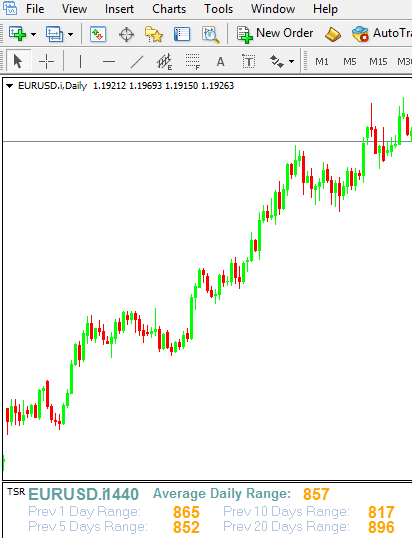
It shows the number 857 as the daily range. But those are not pips.
Because the trading account has a five-digit spread, the indicator shows the last three digits. As such, the average daily range is 85.7 pips.
A five-digit account shows a broker that offers STP (Straight Through Processing) or ECN (Electronic Communication Network) conditions. That’s the best technology to trade with today.
It also shows the average range for the previous day, five days, ten days, and twenty days. Of course, we can edit the period. We can put a hundred days. Or, any number you might think of.
If there’s the data in the trading platform, the indicator will calculate the values.
So, what does the average daily range shows in this example? It shows the EURUSD moved in an almost ninety pips range for the last trading month.
How to use this info? Remember different trading sessions have different ranges?
Average Daily Range Trading Strategy
Smart traders use the daily range data to their advantage. Intraday traders find the info quite necessary.
First, traders know the average daily range from the past. In the EURUSD example, the pair had ninety pips range in the last twenty trading days.
If we are to have an educated guess about next day’s range, what would it be? Of course, around ninety.
After all, trading depends on probabilities. And, Forex traders align their trades with the path of least resistance.
In this case, they use the average true range to set the right take profit. Or, to exit the market.
When trading, you better know your way out, before you go in a trade. That’s where the average daily range comes into play.
Second, traders go on the lower time frames. And, calculate the Asian session range.
Finally, they deduct it from the average daily range. And, set the take profit for the trade.

The EURUSD five-minute chart above shows the Asian session. The price moved in a twenty-five pips range.
However, the average daily range is ninety. Hence, there’s more movement to come.
Like any indicator, it gives an idea of what the market might do. But, for best results, it is recommended to use it together with some other type of technical analysis.
For example, traders use it with the Elliott Waves Theory. If your Elliott count results in a strong impulsive wave, it means the market will move. For any trade, they set the take profit level considering the average range.
Yet, there’s another catch. As mentioned earlier, no trading day is the same.
And, being an average, it’s not mandatory for the price to move that day. Hence, traders use it to measure volatility.
How to Measure Volatility with the Average Daily Range
Volatility differs from market to market. Stock indices show different ranges than the Forex market.
Even in the Forex market, majors, minors, exotics, and cross pairs have different ranges. How about using the range to find out better targets?
A simple concept like the average range is enough to measure volatility. And, with a disciplined approach, Forex traders time the moves.
We all know now that the Forex market mostly ranges. It spends in consolidation patterns most of the time.
Moreover, when it moves, it does it for a reason. Typically, that’s a fundamental one.
Trading the news is one way to approach the Forex market. After all, the two currencies in a currency pair represent two economies.
Interpreting the two economies is fundamental analysis. And, economic releases help to achieve that.
Nowadays, trading algorithms buy and sell a currency pair when news comes out. The average daily range includes that reactions.
How to Measure Volatility in a Trading Week
In a trading week, some days are more important than others. This explains different ranges in different days.
The second part of the week matters more than the first one. As such, expect smaller ranges Monday and Tuesday. And, look for the range to increase in the second half of the week.
That is true for major pairs. Or, the ones that have the USD in their componence.
Those are the important pairs, as the USD is the world’s reserve currency.
But why the volatility rises in the second half of the week? The answer is simple. Key economic data comes out then.
Below is a list of a few economic releases that come out in the second part of the week. They only meant to show you why the average daily range changes towards the end of the week. As such, we have:
- NFP (Non-Farm Payrolls) – every first Friday of the month
- ECB (European Central Bank) press conference – Thursdays, every six weeks
- FOMC (Federal Open Market Committee) decision – Wednesdays evening, every six weeks.
- Bank of England’s interest rate decision – monthly, Thursdays
And so on.
Because the most important news comes late in the week, the market consolidates Monday and Tuesday. That is, most of the times.
Smart traders use this to their advantage. How to measure volatility if you don’t know when the market is supposed to move?
Moreover, the option market has expiries and rollovers on Thursdays.
When this happens, the volatility is on the rise. But, how to measure volatility? And, how to use the info?
Step by Step Guide on How to Measure Volatility
So far, we established no trading day is like the other. And, no trading week either.
It is time to look at how to measure volatility with the average daily range. It is a step by step process. And, it starts on Mondays.
Let’s use the data we already have. The EURUSD daily range for the last twenty trading days is almost ninety pips.
But, this Monday, the pair traveled less. The OHLC data below shows the difference between the high and the low being fifty-four.
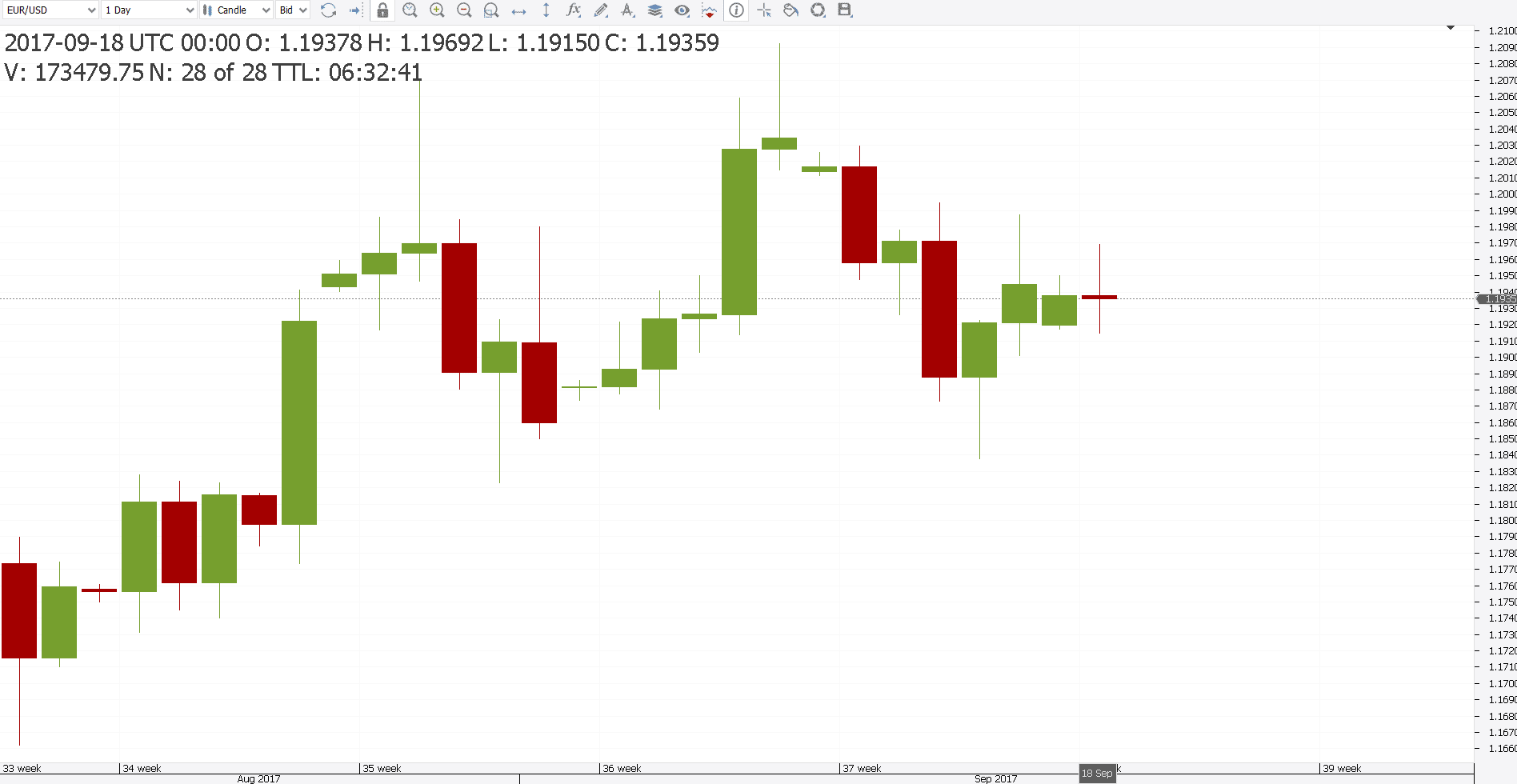
That’s only about half of the average daily range over the past trading month. However, the Asian and London session ended.
And, the volatility is subdued. That’s normal on Mondays. We explained earlier why.
But, traders use this info in their favor. Here’s how to measure volatility for the EURUSD pair for the rest of the week.
We know the ninety pips average daily range. And, the fifty-four pips range today.
Traders use the thirty-six pips difference to calibrate expectations for the next trading days. For the average daily range to be ninety, at least one of the following days will have a bigger range.
Let’s assume Tuesday has an even smaller range. Implications are that Wednesday, Thursday, and Friday the price will move.
And this is how to measure volatility with such a simple concept. The average daily range helps with it.
Volatility is significant in Forex trading. No one wants to block margin in a market that doesn’t move.
That’s expensive. Most currency pairs have a negative swap.
If you keep a position overnight, you’ll pay some. The average daily range Forex pairs have, differs too. Therefore, volatility expectations change on various pairs.
Tips and Tricks when Using the Average Daily Range
Unfortunately, retail traders don’t pay attention to details. That’s a rookie mistake.
They assume any indicator shows the same data on all brokers. Ouch!
A simple detail like this one is enough to misinterpret data. Let me give you an example.
The MetaTrader4, or any trading platform, shows the price feed. Namely, the candles, let’s say.
The opening, closing, and so on. But, the info differs from broker to broker.
It depends on where the broker servers are. Some servers are in GMT+ 0 time zone. Others, in GMT+3. And so on.
Why is this important? Well, it is crucial to an indicator that uses info from the daily time frame.
Therefore, it is vital for the average daily range. That is true for two reasons:
- The closing price differs.
- The Sunday candle influences the average daily range.
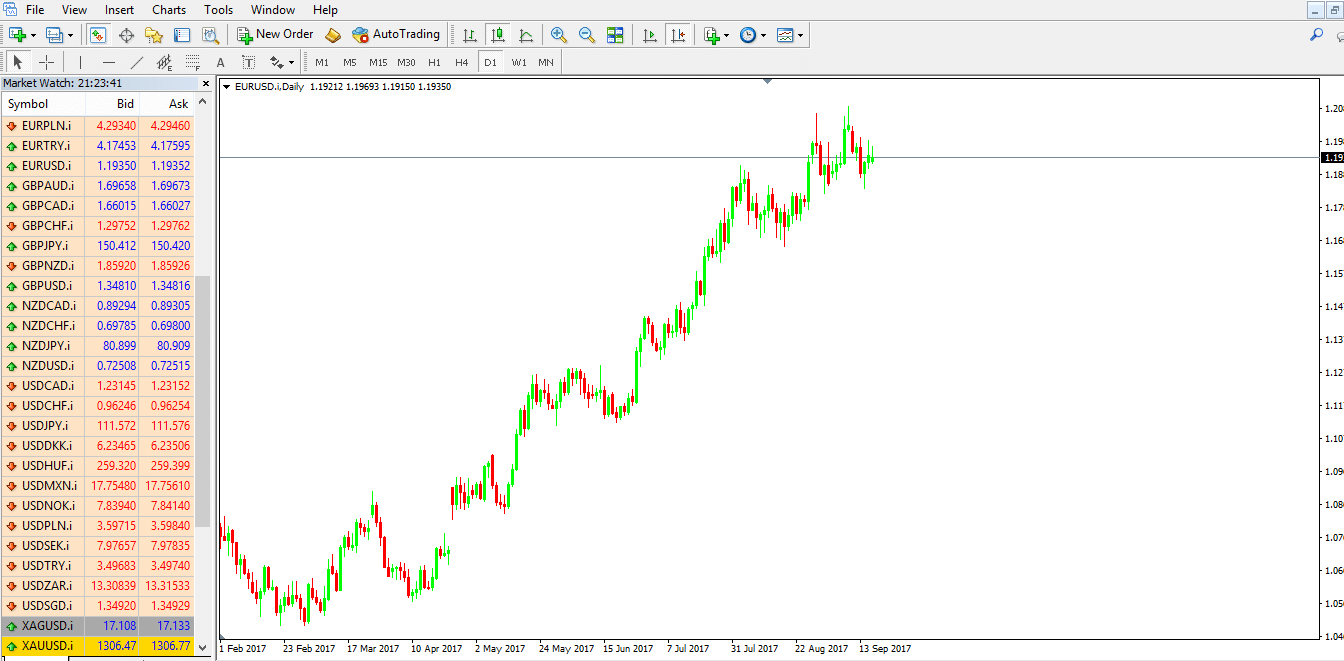
Because this simple detail will have the daily candle closing earlier or later in a trading week. Recently, Forex brokers tried to get rid of the “Sunday candle.”
On Sunday, trading takes place. Did you know that?
The New Zealand market opens on Monday, while in Europe and North America it is still Sunday. That’s enough trading activity for a couple of hours.
A daily candle forms. A small one, with a low average daily range.
Typically, that’s a period of low volatility. And, small market movements.
As such, if you use the average daily range indicator on a broker that shows the Sunday candle, the averages will be smaller. Such a simple thing changes everything!
Conclusion
The Forex market is complex. Trading currencies is not for everyone.
Before anything, one must understand how the market moves. There’s nothing wrong with expecting to make a million pips in profits.
But, it’s unrealistic. Volatility differs. And, when the market doesn’t move, there’s nothing to do about it.
However, volatility won’t stay low forever. And, how to measure volatility if not with the average daily range?
Yet, the way the market is presented to us differs too. Because of that, the data we look at and interpret changes.
A daily range is nothing but some pure math applied on some prices. But, if those prices change from broker to broker, traders must pay attention to it.
The average daily range isn’t the only way how to measure volatility. Various volatility indicators exist.
For example, the Bollinger Bands indicator measures the instability of a currency pair. The narrower the distance between the bands becomes, the bigger the expected reaction.
But, the average daily range shows realistic market expectations. When used together with other technical analysis concepts, the data proves to be decisive in finding the right target.
To sum up, the average daily range shows how to measure volatility. Or, when the market will travel the most.
Of course, it is just an educated guess. But, it works most of the times. Therefore, knowing how to use the average daily range, increases the chances of profitable trading.
